Last night, I watched a German news broadcast about unethical repairmen overcharging their customers. A reporter posing as a housewife had three different repairmen look at her fully functional refrigerator. All three declared that it needed all kinds of work: a new thermostat, a new freezer unit, you name it. One of them took the freezer unit’s temperature and declared that it was only cooling to 45 degrees F (7 decrees C), which was odd since it was successfully keeping ice at the time. A broadcast label under the reporter/housewife announced that she was der Lockvogel. That’s the kind of Vogel, or bird, that helps with locken: luring, fooling, and trapping something. Der Lockvogel is a decoy or stool pigeon.
A Monument from a Bygone Age … the 1990s
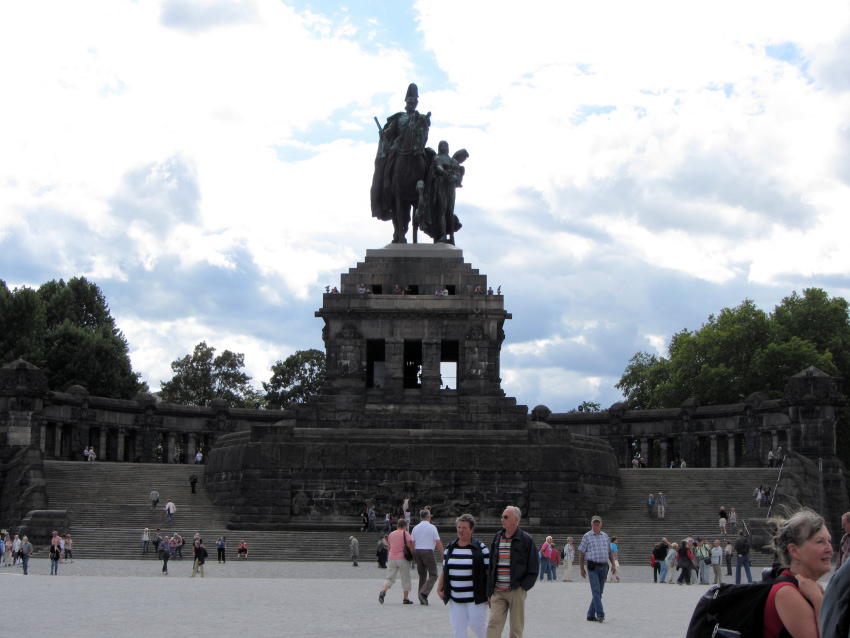
This enormous bronze equestrian statue of Kaiser Wilhelm I towers over the crowds at the Deutsches Eck, the spit of land in downtown Koblenz where the Mosel flows into the Rhine. Standing almost fifty feet high (14 meters) from plumed helmet to hooves and weighing almost 70 US tons, it embodies a spirit of nationalistic pride that speaks of a young, freshly unified Germany.
The sentiment is Old World. But the bronze … not so much.
During the last few centuries, this ancient and culturally important German city has spent a fair amount of time in the hands of the French and the Russians. So, when Germany unified in the 1800s and Koblenz came back into the fold, a grateful citizenry chose this spot to erect a monument in celebration. The Deutsches Eck plaza and its guardian statue were completed in 1897. More than a monument to Wilhelm I, it was a monument to German unification, and words carved into its granite base urged the Germans to remain united and loyal.
Then a whole lot of history happened, and in 1945, an American artillery shell destroyed the great statue. Koblenz was once more in the hands of the French, and East Germany was lost. So, in 1953, the German president came to the Deutsches Eck and dedicated it to the goal of reunification. From then on, a huge German flag flew over the plaza.
In 1989, that reunification finally occurred. Now, what to do with the Deutsches Eck?
Lots of alternatives were proposed, but the residents of Koblenz wanted their old Kaiser back, and when a Koblenz couple announced that they would pay to recreate the statue, the city happily agreed. In 1993, a crane lifted the new Kaiser Wilhelm into place.
So he’s back.
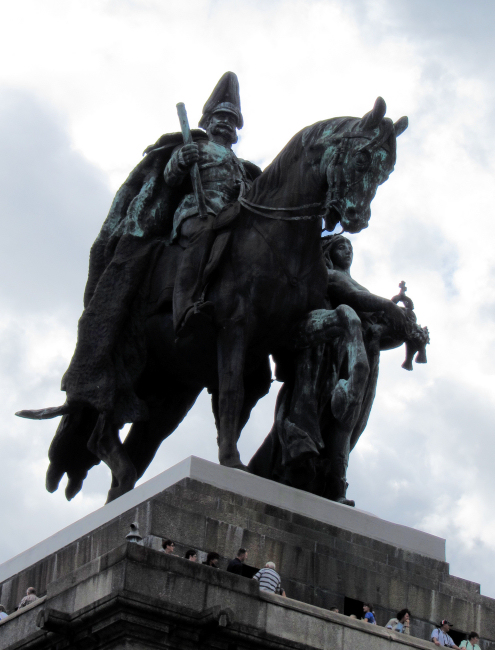 Photographs taken September, 2011, in Koblenz, Germany. Text copyright 2011 Clare B. Dunkle. Photos copyright 2011 Joseph R. Dunkle.
Photographs taken September, 2011, in Koblenz, Germany. Text copyright 2011 Clare B. Dunkle. Photos copyright 2011 Joseph R. Dunkle.
The top dog in Germany isn’t a dog. He’s a stag. He’s der Platzhirsch: the toughest, biggest stag in the meadow. In autumn, he spends a lot of his time rounding up his harem of does and fighting off anybody who comes near them. The other stags stand around and bellow, but he doesn’t care because he has all the pretty girls to himself, plus the fast cars, Rolex watches, stock options, and vacation homes in the Caribbean. Does he need it all? No, but he keeps it anyway, and shows it off to his less fortunate colleagues. Because he’s a Platzhirsch. And that’s what they do.
Flowers and Books
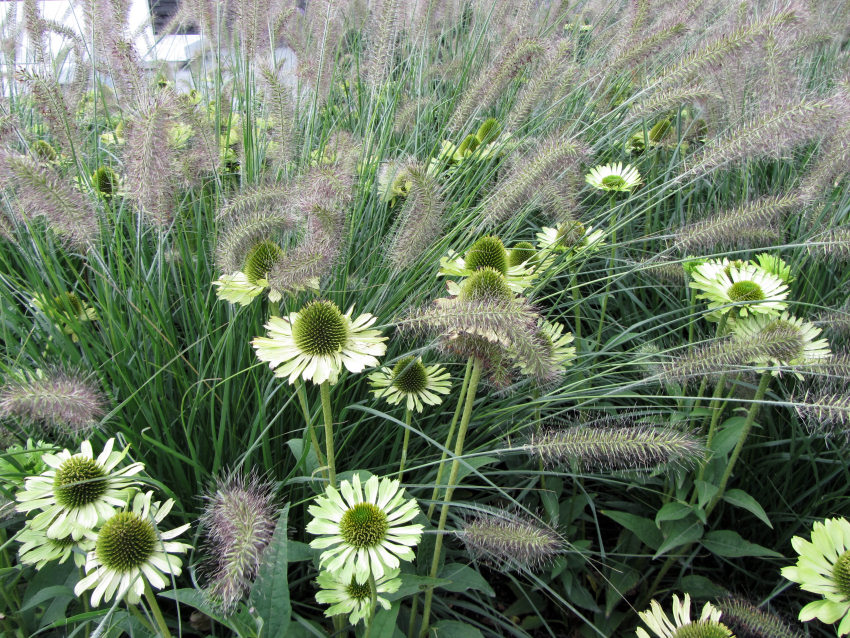
What did Joe and I find at the Koblenz National Garden Show? Well, we found flowers, of course. According to the brochures, there were 6,000 square yards of roses alone (5,000 square meters). Everywhere we looked, we saw fabulous combinations of height, texture, and color.
But we also found books.
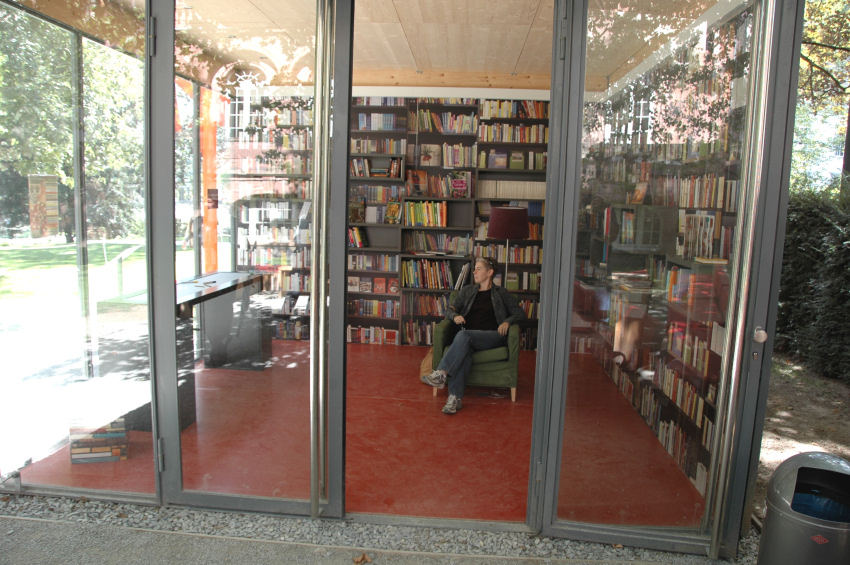
In a wooded area near the Rhine Promenade, we found this little reading room, complete with one easy chair. (Apparently, reading should be a solitary pursuit.) It was very pleasant to find that books and reading hadn’t been forgotten.
A sign assured us that the books represented here were works by prominent Rhineland-Palatinate authors, that being the part of Germany hosting the National Garden Show. But I think the sign referred to the books printed on the wallpaper. Most of the books you see on the “shelves” here are a “life-size” photographic representation of full bookshelves pasted down as wallpaper. I could run my finger along the shelves and read the spines just as if I were standing at a real bookshelf.
Still, I was pleased to find an interesting assortment of real books in the reading lounge. There were several shelves of children’s books, a nice array of garden books, the Bible, and an eclectic assortment of novels. Among them, I found this old friend:
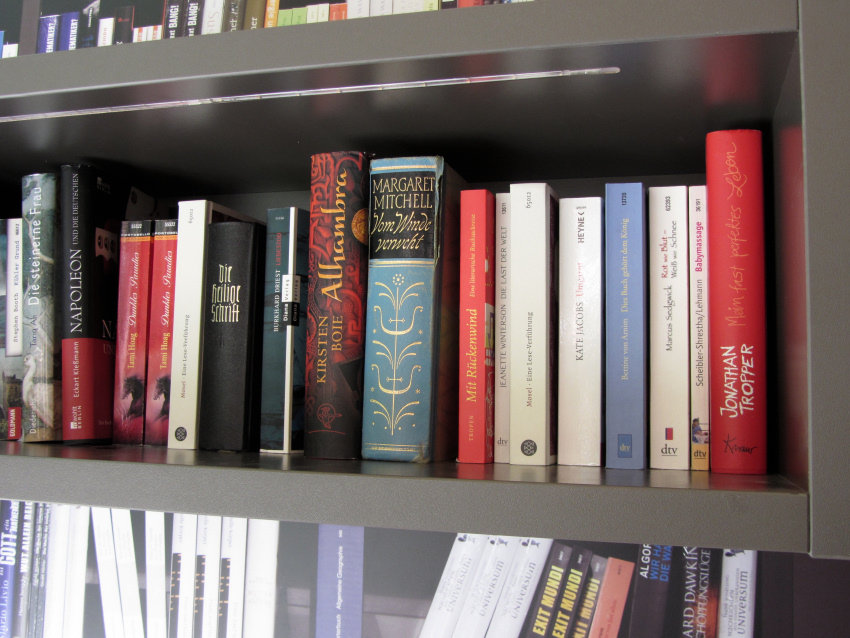
Yep, that’s Margaret Mitchell’s GONE WITH THE WIND. Nope, I don’t understand it either.
Photographs taken September, 2011, in Koblenz, Germany. Text copyright 2011 Clare B. Dunkle. Photos copyright 2011 Joseph R. Dunkle.
The other day, I was watching one of the German zoo shows. A woman zookeeper was currycombing what I’m pretty sure was a tapir just as if he were a pony, and I wasn’t surprised because the animals I’ve seen in German zoos have been bursting with good health, good looks, and high spirits. Finally, she gave his rump a pat and said with evident satisfaction, “Du glänzt wie eine…” and then came a word that led me a merry dance through my dictionary and finally to my friend Heidi, who knew all about it.
What had she said? “Du glänzt wie eine Speckschwarte.” “You gleam like a bacon rind.” And he did!
Flowers in Downtown Koblenz
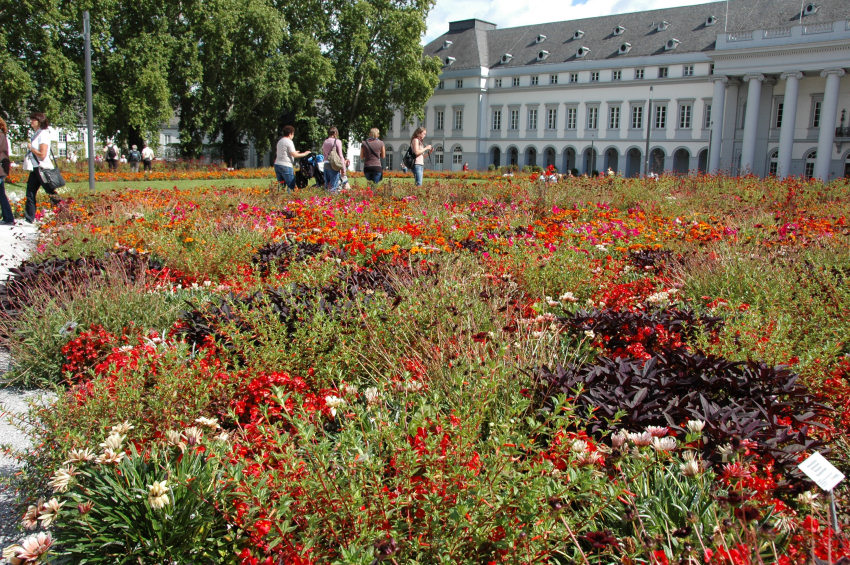
This weekend, Joe and I drove to Koblenz to visit the National Garden Show, a traveling event which takes place every two years. For six months, a German city transforms part of itself into a blooming paradise, and millions of visitors come from all over the world–and also all over Germany–to enjoy the result. The next Garden Show (international this time) will be in Hamburg. I can’t imagine a comparable event being held in the States, sadly enough. Maybe it’s that we’re too big a country to pull off something like this. Or maybe we don’t want to spend the public funds.
Koblenz is very old and very important. It only misses being the oldest city in Germany by about twenty years. The Romans founded it in 9 BC when they established a military post at the confluence of the Rhine and the Mosel rivers, and it’s the Latin word for confluence that gives Koblenz its name. The point where the Mosel flows into the Rhine–two wide and impressive rivers–is called the Deutsches Eck, or German Corner. The high cliffs of Ehrenbreitstein, on the other side of the Rhine river, overlook the Deutsches Eck. This grim-looking rock, once known as the Gibralter of the Rhine, was already an ancient fortification site when the Romans took it over. It has been occupied for three millennia, and it is covered with military ruins.
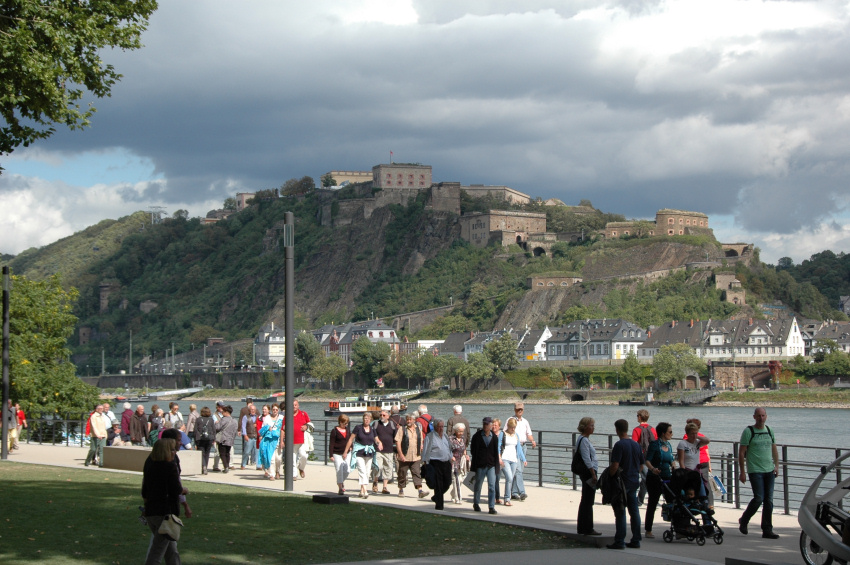
It is a masterstroke and a wonder that Koblenz could turn this part of the city once vital to defense into the heart of its National Garden Show. Flowerbeds decorate the promenade along the Rhine, and an impressive cable car line now links the Deutsches Eck with Ehrenbreitstein, where a 66 acre (27 hectare) park has been laid out on what must have been the flat parade ground of the fortress.
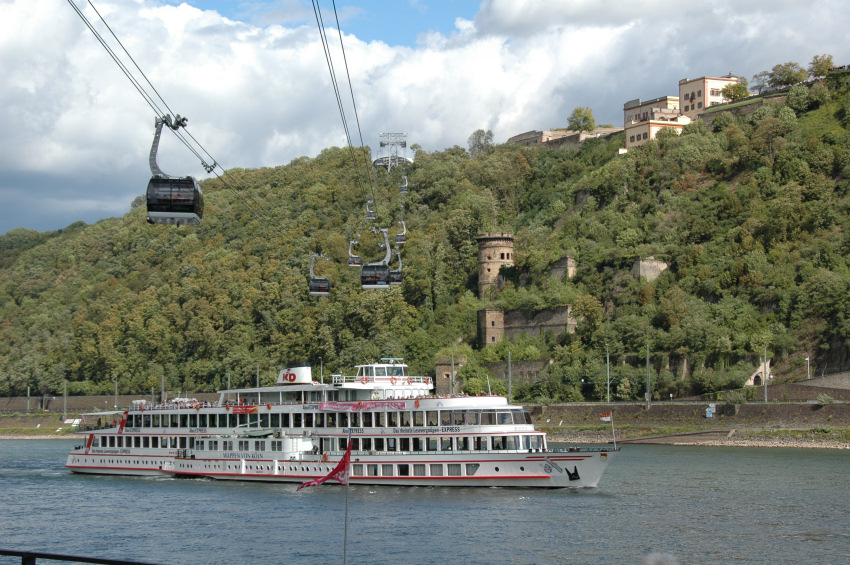
More on the Koblenz Garden Show tomorrow.
Photographs taken September, 2011, in Koblenz, Germany. Text copyright 2011 Clare B. Dunkle. Photos copyright 2011 Joseph R. Dunkle
I like to think of German as the Lego language: the basic words and prefixes combine to convey more complex meanings. The prefix er- has no meaning of its own, but it takes its base word to the limit, to its ultimate conclusion. So, folgen, to follow or to continue, but der Erfolg, success. And schiessen, to shoot, but erschiessen, to shoot dead. Geben, to give, but ergeben, to surrender. And trinken, to drink. But ertrinken–to drown!
More whimsical Germany
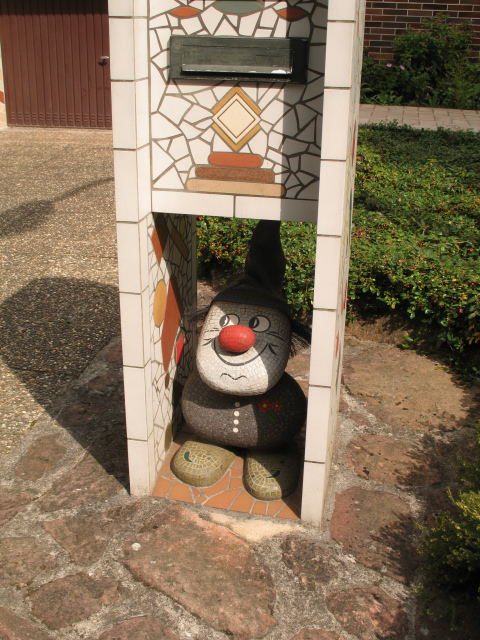
Speaking of that sense of magical fun and good humor that often emerges in German public art, here is a little charmer who resides two doors down from my apartment. She’s peeping out at the world from underneath the mailbox, and she appears to be a variety of the beloved German kitchen witch. The kitchen witch, like Astrid Lindgren’s Tomten, looks out for her house and keeps bad things and bad magic away. One sees little kitchen witch dolls flying on their broomsticks in the windows of many houses over here, and even in restaurants or hotels. No one knows if the tradition originated in Scandinavia or Germany, but it is firmly entrenched. This witch is made out of concrete and beautifully decorated with bits of ceramic tile, with a hat and hair of fabric. I don’t know how anyone could see her and not smile.
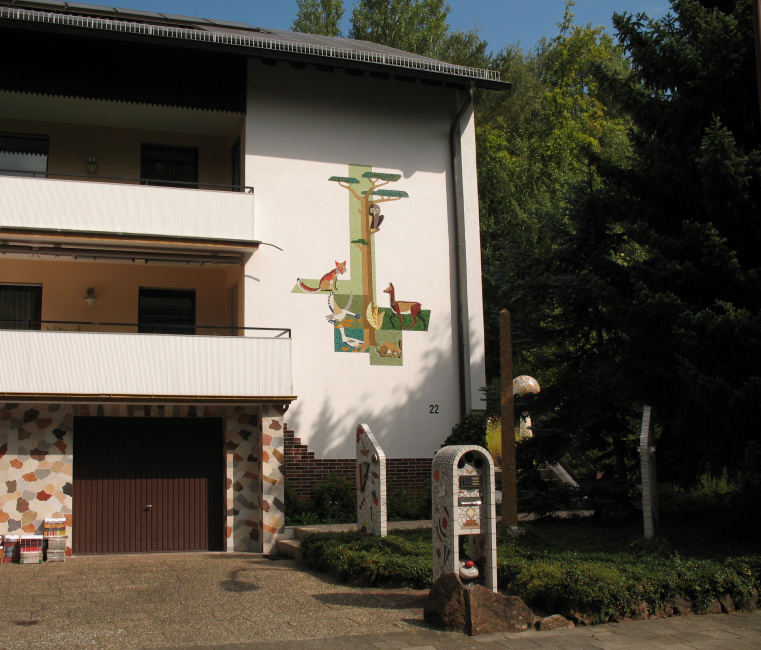
The little witch’s house must belong to an artist because it has several interesting sculptures in the garden, as well as a gorgeous ceramic mosaic on the front wall. I don’t know the tradition behind these sorts of large pictures on building walls, but I see them frequently as I travel around Germany. Most of them are paintings, though. This one is especially nice.
Photographs taken September, 2011, in Rodenbach, Germany. Text and photos copyright 2011 Clare B. Dunkle.
Whimsical Germany
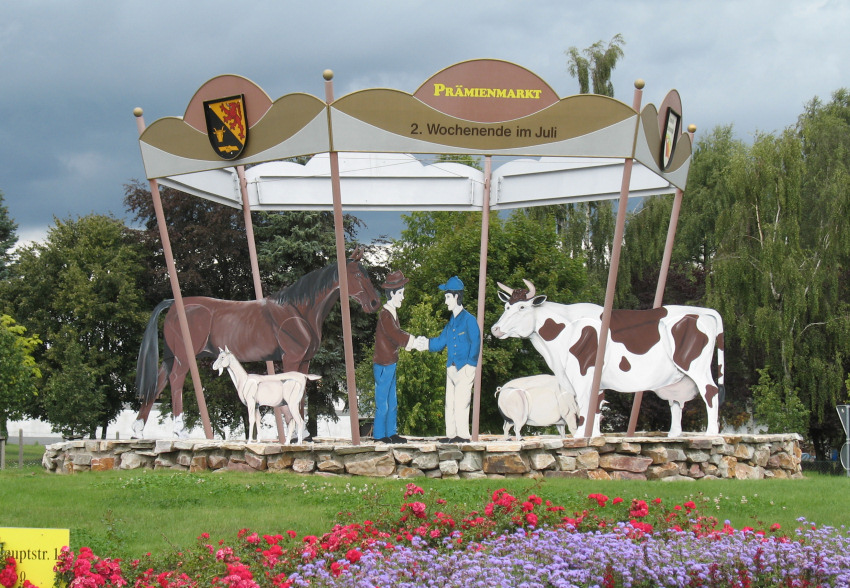
From an American point of view, German culture often exhibits a streak of whimsy. My introduction to this came before I arrived in Germany, back in 1999. I was paging through a coffee table book on Hanover and encountered the image of a fountain: the front half of a horse is drinking from a watering trough, but his back half is missing, and his rider has turned to look with amazement at the water spraying out where the rest of the horse should be. The fountain, which is in Bodenwerder, commemorates one of the adventures of Baron Munchausen, in which his fiery Lithuanian stallion helps him rout the enemy–in spite of having been cut in half. Both halves of the horse are in great form that day (in different locations, of course), and a vet eventually sews them back together.
That sense of gentle humor and magical wonder regularly shows up in German public art. I find it refreshing because unlike our tradition of sarcasm, this humor isn’t mean-spirited and comes at no one’s expense. Joe and I were on our way to Trittenheim this weekend when we encountered the charming display in the photo above. The figures are life-size, and they stand in the middle of a roundabout at Herborn (I think). They’re advertising a “praemienmarkt,” and I’m not sure quite what that would be, unless it’s a chance for farmers and insurance agents to intermingle. Or perhaps it’s a village fest sponsored by an insurance company.
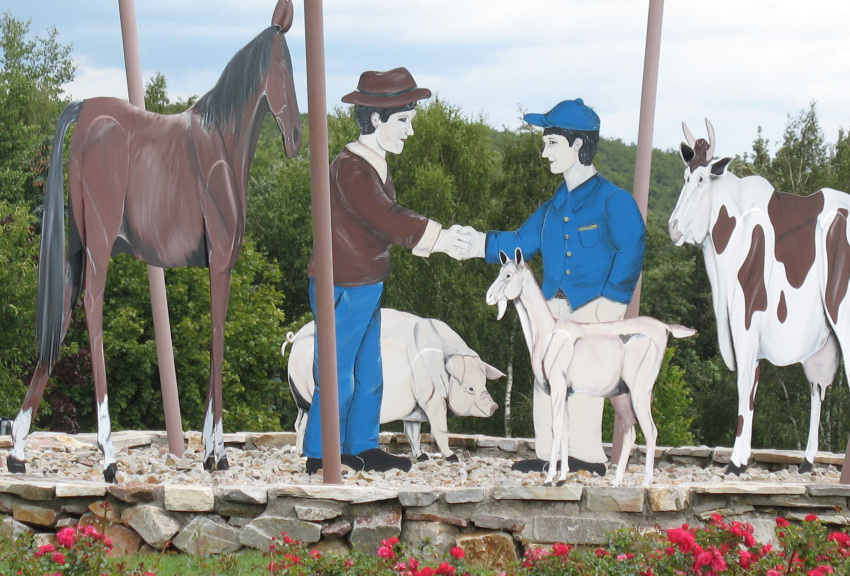
In any case, it’s brought us this happy set of farm animals made out of painted metal. I particularly like the smiling pig.
Photographs taken August, 2011, near Herborn, Germany. Text copyright 2011 Clare B. Dunkle. Photos copyright 2011 Joseph R. Dunkle
Escape from the Dust
Why do I love northern Europe? Because I’m from Texas, the land of barbed wire, mesquite trees, and prickly pear cactus. The beauty of Texas is severe. And some years, there’s no beauty at all.
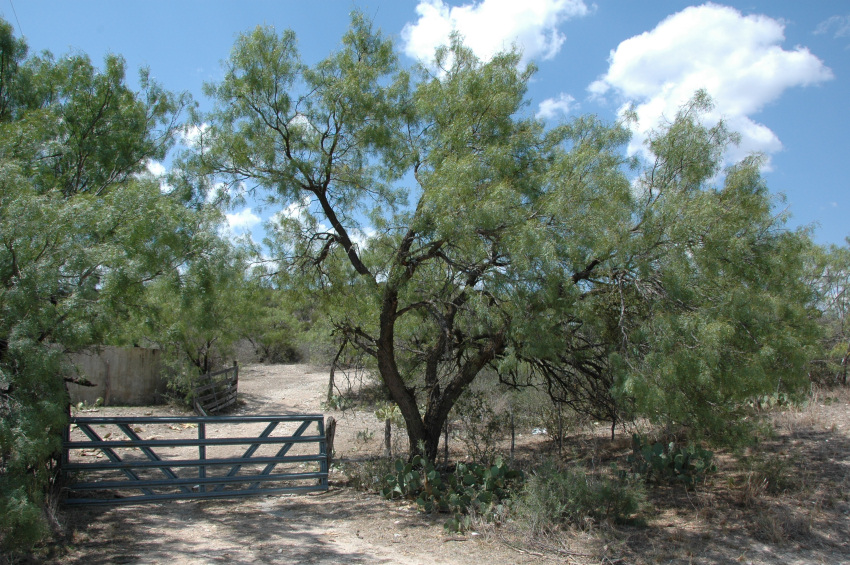
This year is a dry year. I live in San Antonio, in central Texas, and this year we’ve been getting the kind of rainfall that the desert states get: six and a half inches so far, or 167 mm, and it’s almost September. But that kind of weather could change overnight. Four years ago, my city received almost fifty inches of rainfall (1200 mm). And I’ve seen it rain over eleven inches (285 mm) in one day.
Thunderstorms, flash floods, tornados, hurricanes, and brush-fires started by lightning strikes: there’s nothing gentle about Texas weather. But drought is the worst of all. I grew up listening to adults worry about their lawns and pets during hot, dry spells. News reports regularly chronicled crop failures and the plight of hungry cattle as the grass shriveled up and the dusty earth baked. I remember as a child watching miserable birds pant in the heat.
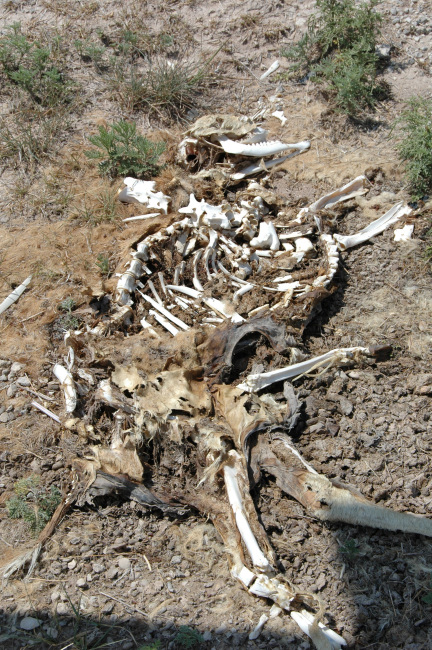
This year has been so dry that this doe and her unborn fawn had no chance. Most people love the sunshine, but to this girl from north Texas, too many sunny days in a row means death.
But now my husband has been assigned temporarily to a job near Kaiserslautern, Germany. We get to escape the heat for a while. Kaiserslautern has had more rain in the last six weeks than San Antonio has had in six months. Everywhere I look, I see green.
I intend to make the most of my short time in Germany, and I’ll tell you about some of the interesting things I find here. Welcome to my blog.
Photographs taken July, 2011, in the Texas Hill country. Text copyright 2011 Clare B. Dunkle. Photos copyright 2011 Joseph R. Dunkle.
